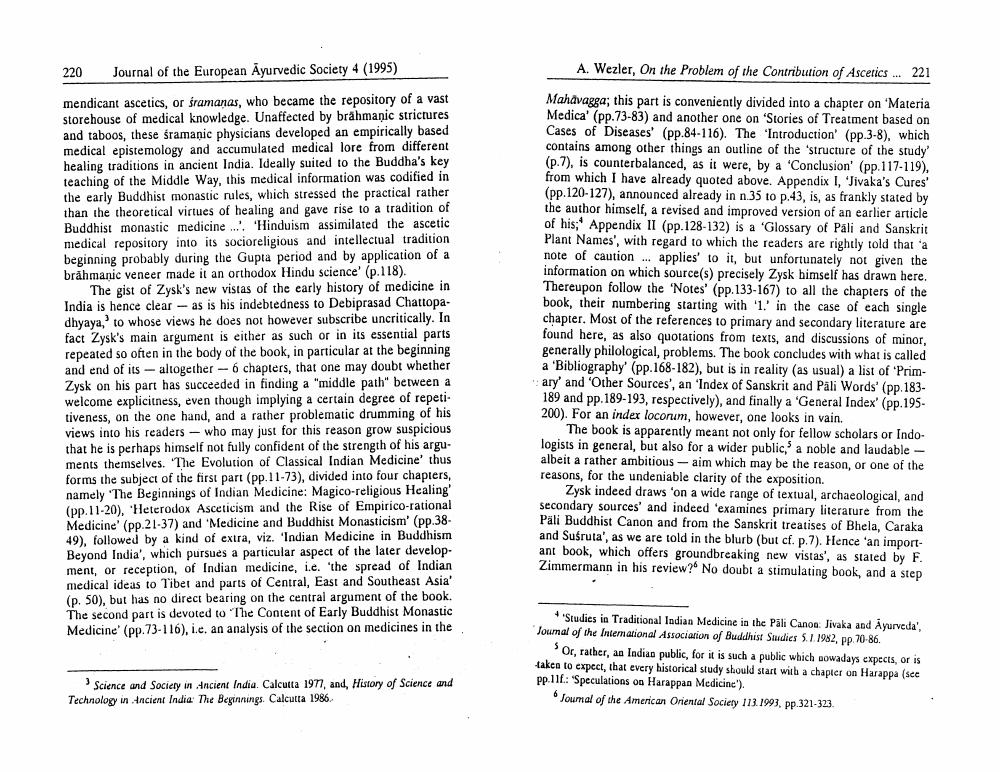________________
220
Journal of the European Ayurvedic Society 4 (1995)
A. Wezler, On the Problem of the Contribution of Ascetics ... 221
mendicant ascetics, or śramanas, who became the repository of a vast storehouse of medical knowledge. Unaffected by brahmanic strictures and taboos, these sramanic physicians developed an empirically based medical epistemology and accumulated medical lore from different healing traditions in ancient India. Ideally suited to the Buddha's key teaching of the Middle Way, this medical information was codified in the early Buddhist monastic rules, which stressed the practical rather than the theoretical virtues of healing and gave rise to a tradition of Buddhist monastic medicine ...'. 'Hinduism assimilated the ascetic medical repository into its socioreligious and intellectual tradition beginning probably during the Gupta period and by application of a brahmanic veneer made it an orthodox Hindu science' (p.118).
The gist of Zysk's new vistas of the early history of medicine in India is hence clear - as is his indebtedness to Debiprasad Chattopadhyaya,' to whose views he does not however subscribe uncritically. In fact Zysk's main argument is either as such or in its essential parts repeated so often in the body of the book, in particular at the beginning and end of its - altogether - 6 chapters, that one may doubt whether Zysk on his part has succeeded in finding a "middle path" between a welcome explicitness, even though implying a certain degree of repeti. tiveness, on the one hand, and a rather problematic drumming of his views into his readers - who may just for this reason grow suspicious that he is perhaps himself not fully confident of the strength of his arguments themselves. 'The Evolution of Classical Indian Medicine' thus forms the subject of the first part (pp. 11-73), divided into four chapters, namely 'The Beginnings of Indian Medicine: Magico-religious Healing' (pp. 11-20). 'Heterodox Asceticism and the Rise of Empirico-rational Medicine (pp.21-37) and Medicine and Buddhist Monasticism' (pp.3849), followed by a kind of extra, viz. 'Indian Medicine in Buddhism Beyond India', which pursues a particular aspect of the later development, or reception, of Indian medicine, i.e. 'the spread of Indian medical ideas to Tibet and parts of Central, East and Southeast Asia' (p. 50), but has no direct bearing on the central argument of the book. The second part is devoted to 'The Content of Early Buddhist Monastic Medicine (pp.73-116), i.e. an analysis of the section on medicines in the
Mahavagga; this part is conveniently divided into a chapter on Materia Medical (pp.73-83) and another one on 'Stories of Treatment based on Cases of Diseases (pp.84-116). The 'Introduction' (pp.3-8), which contains among other things an outline of the structure of the study (p.7), is counterbalanced, as it were, by a 'Conclusion' (pp. 117-119), from which I have already quoted above. Appendix I, 'Jivaka's Cures' (pp.120-127), announced already in n.35 to p.43, is, as frankly stated by the author himself, a revised and improved version of an earlier article of his; Appendix II (pp. 128-132) is a 'Glossary of Páli and Sanskrit Plant Names', with regard to which the readers are rightly told that 'a note of caution ... applies' to it, but unfortunately not given the information on which source(s) precisely Zysk himself has drawn here. Thereupon follow the 'Notes' (pp.133-167) to all the chapters of the book, their numbering starting with '1.' in the case of each single chapter. Most of the references to primary and secondary literature are found here, as also quotations from texts, and discussions of minor, generally philological, problems. The book concludes with what is called a 'Bibliography' (pp.168-182), but is in reality (as usual) a list of 'Primary' and 'Other Sources', an 'Index of Sanskrit and Pali Words' (pp.183189 and pp.189-193, respectively), and finally a "General Index' (pp.195200). For an index locorum, however, one looks in vain.
The book is apparently meant not only for fellow scholars or Indologists in general, but also for a wider public, a noble and laudable albeit a rather ambitious - aim which may be the reason, or one of the reasons, for the undeniable clarity of the exposition.
Zysk indeed draws 'on a wide range of textual, archaeological, and Secondary sources' and indeed 'examines primary literature from the Pali Buddhist Canon and from the Sanskrit treatises of Bhela, Caraka and Susruta', as we are told in the blurb (but cf. p. 7). Hence 'an important book, which offers groundbreaking new vistas', as stated by F. Zimmermann in his review? No doubt a stimulating book, and a step
4 Studies in Traditional Indian Medicine in the Pali Canoa: Jivaka and Ayurveda'. Journal of the Intemational Association of Buddhist Studies 5.1.1982, pp. 70-86.
Or, rather, an Indian public, for it is such a public which nowadays expects, or is akce to expect that every historical study should start with a chapter on Harappa (sce pp.11f: 'Speculations on Harappan Medicine').
Toumal of the American Oriental Society 113.1993. pp.321-323
Science and Society in Ancient India. Calcutta 1977, and, History of Science and Technology in Ancient India: The Beginnings. Calcutta 1986




